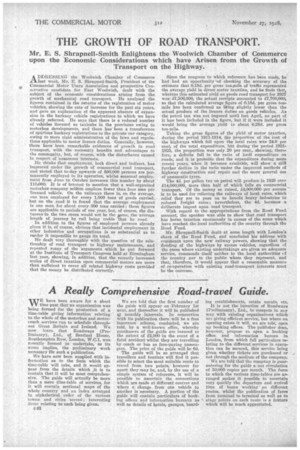• THE GROWTH OF ROAD TRANSPORT.
Page 30

If you've noticed an error in this article please click here to report it so we can fix it.
Mr. E. S. Shrapnell-Smith Enlightens the Woolwich Chamber of Commerce upon the Economic Considerations which have Arisen from the Growth of Transport on the Highway.
ADDRESSING the Woolwich Chamber of Commerce last week, Mr. E. S. Shrapned-Smith, President of the Commercial Motor Veers Association and prospective Conservative candidate for East Woolwich, dealt with the subject of the economic considerations arising from the growth of mechanical road transport. He analysed the figures. contained in the returns of the registration of motor vehicles, showing the rate of increase for the past six years, and gave an explanation of the apparent absence of expansion in the hackney vehicle registrations to which we have already referred. He says that there is a reduced number of vehicles licensed as taxicabs in the provinces owing to motorbus developments, and there has been a transference of en-tithing hackney registrations to the private car category, owing to more rigid administration of the laws and regulations applicable to motor licence duties. Generally, however, there have been remarkable evidences of growth in road transport, with the neceeseey benefits and advantages to the community, but, of course, with the disturbance caused in respect of numerous interests.
He thinks that employment, both direct and imlireet, has improved under the growth of commercial road transport, and stated that to-day upwards of 800,000 persons are permanently employed in its operation, whilst seasonal employmeet from Juno to October increases this number by about 110;000. It is of interest to mention that a well-organized motorbus company seldern employs feWer than four men per licensed vehicle. On the railways there is, on the average, rine man employed for every 1,000 tons of goods carried, but on the road it is found that the average employment is one man, for about every 400 tons carried; these figures are applicable to periods of one year, but, of course, the distances-in the two cases would not be the ime, the average length of journey by rail being treble that by road. • In addition to the figures of employed Persons already given it f, of course, obvious that incidental employment in other industries and occupations is so substantial as to render it impossible to gauge its total. He dealt very thoroughly with the question of the relatinnship of road transport to highway maintenance, and repeated many of the arguments which he put forward at the Institute of Transport Congress held at Birmingham last year, showing, in addition, that the recently increased scales of direct taxation upon commercial motors are more than 8-efficient to cover all related highway costs provided that the money be distributed correctly. Since the congress to which reference has been made, he had had an opportunity 'of checking the accuracy of the estimate that 0.18d. per gross ton-.mile of traffic represented the average yield in direct motor taxation, and he finds that, whereas this estimated yield on goods road transport for 1927 was £7,506,000, the actual receipts amounted to £7,700,000, so that the calculated average figure of 0.18d. per gross tonmile has been confirmed as being slightly lower than the actual produce of the licence duties on goods vehicles. As the petrol tax was not imposed until last April, no part of it ha s beets included in the figure, but if it were included it would bring the average yield to about 0.28d. per gress
Taking the gross figures of the yield of motor taxation, during the period 1911-1914, the proportion of the cost of the highways which fell upon the local rates was 24.9 per cent, of the total expenditure, but during the period 19211925, the proportion was only 20 per cent., showing, therefore, a definite fall in the ratio of locdl expenditure ott roads, and it is probable that the expenditure during more recent years, when it becomes available, will show a still further decline in the ratio under the improved methods of highway construction and repair and the more general use of pneumatic tyres.
The 4d. per gallon tax on petrol will produce in 1929 over £14,000,000, more than half of which falls on commercial transport. Of the money so raised, £4,000,000 per annum is to be used for relieving the railways of local rates, which relief they are to pass on to benefit heavy industries in reduced freight rates ; nevertheless, the 4d becomesa deliberate impost upon road transport.
With regard to the appropriations from the Road Fund account, the speaker was able to show that road transport has borne taxation enormously in excess of the sums which have reached the local authorities of the country through tho Road Fund.
Mr. Shrapnell-Smith dealt at some length with London's share of the Road Fund, and concluded his address with conionents upon the new railway powers, showing that the flooding of the highways by excess vehicles, regardless of the cases where existing undertakings are given an adequate service, eommends itself neither to the local authoritiescf the country nor to the public whom they represent, and that, therefore, it would appear that a reasonable measure , of co-operation with existing road-transport interests must be the outcome. • '


































